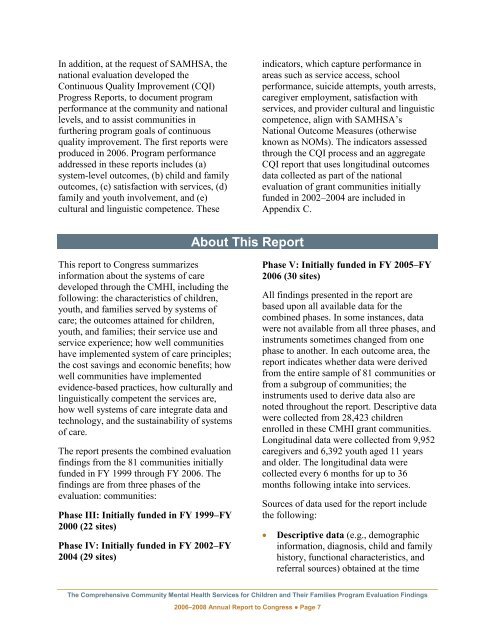Evaluation Findings - SAMHSA Store - Substance Abuse and Mental ...
Evaluation Findings - SAMHSA Store - Substance Abuse and Mental ...
Evaluation Findings - SAMHSA Store - Substance Abuse and Mental ...
You also want an ePaper? Increase the reach of your titles
YUMPU automatically turns print PDFs into web optimized ePapers that Google loves.
In addition, at the request of <strong>SAMHSA</strong>, the<br />
national evaluation developed the<br />
Continuous Quality Improvement (CQI)<br />
Progress Reports, to document program<br />
performance at the community <strong>and</strong> national<br />
levels, <strong>and</strong> to assist communities in<br />
furthering program goals of continuous<br />
quality improvement. The first reports were<br />
produced in 2006. Program performance<br />
addressed in these reports includes (a)<br />
system-level outcomes, (b) child <strong>and</strong> family<br />
outcomes, (c) satisfaction with services, (d)<br />
family <strong>and</strong> youth involvement, <strong>and</strong> (e)<br />
cultural <strong>and</strong> linguistic competence. These<br />
indicators, which capture performance in<br />
areas such as service access, school<br />
performance, suicide attempts, youth arrests,<br />
caregiver employment, satisfaction with<br />
services, <strong>and</strong> provider cultural <strong>and</strong> linguistic<br />
competence, align with <strong>SAMHSA</strong>’s<br />
National Outcome Measures (otherwise<br />
known as NOMs). The indicators assessed<br />
through the CQI process <strong>and</strong> an aggregate<br />
CQI report that uses longitudinal outcomes<br />
data collected as part of the national<br />
evaluation of grant communities initially<br />
funded in 2002–2004 are included in<br />
Appendix C.<br />
About This Report<br />
This report to Congress summarizes<br />
information about the systems of care<br />
developed through the CMHI, including the<br />
following: the characteristics of children,<br />
youth, <strong>and</strong> families served by systems of<br />
care; the outcomes attained for children,<br />
youth, <strong>and</strong> families; their service use <strong>and</strong><br />
service experience; how well communities<br />
have implemented system of care principles;<br />
the cost savings <strong>and</strong> economic benefits; how<br />
well communities have implemented<br />
evidence-based practices, how culturally <strong>and</strong><br />
linguistically competent the services are,<br />
how well systems of care integrate data <strong>and</strong><br />
technology, <strong>and</strong> the sustainability of systems<br />
of care.<br />
The report presents the combined evaluation<br />
findings from the 81 communities initially<br />
funded in FY 1999 through FY 2006. The<br />
findings are from three phases of the<br />
evaluation: communities:<br />
Phase III: Initially funded in FY 1999–FY<br />
2000 (22 sites)<br />
Phase IV: Initially funded in FY 2002–FY<br />
2004 (29 sites)<br />
Phase V: Initially funded in FY 2005–FY<br />
2006 (30 sites)<br />
All findings presented in the report are<br />
based upon all available data for the<br />
combined phases. In some instances, data<br />
were not available from all three phases, <strong>and</strong><br />
instruments sometimes changed from one<br />
phase to another. In each outcome area, the<br />
report indicates whether data were derived<br />
from the entire sample of 81 communities or<br />
from a subgroup of communities; the<br />
instruments used to derive data also are<br />
noted throughout the report. Descriptive data<br />
were collected from 28,423 children<br />
enrolled in these CMHI grant communities.<br />
Longitudinal data were collected from 9,952<br />
caregivers <strong>and</strong> 6,392 youth aged 11 years<br />
<strong>and</strong> older. The longitudinal data were<br />
collected every 6 months for up to 36<br />
months following intake into services.<br />
Sources of data used for the report include<br />
the following:<br />
<br />
Descriptive data (e.g., demographic<br />
information, diagnosis, child <strong>and</strong> family<br />
history, functional characteristics, <strong>and</strong><br />
referral sources) obtained at the time<br />
The Comprehensive Community <strong>Mental</strong> Health Services for Children <strong>and</strong> Their Families Program <strong>Evaluation</strong> <strong>Findings</strong><br />
2006–2008 Annual Report to Congress ● Page 7

















